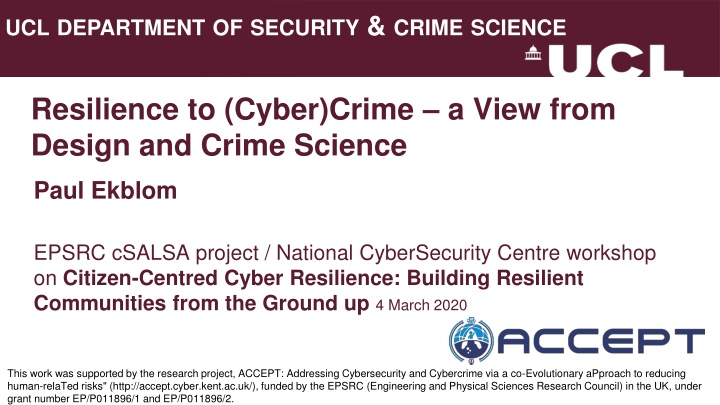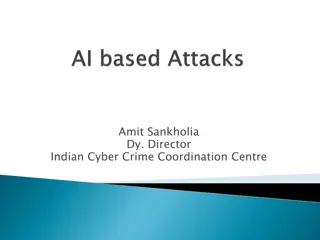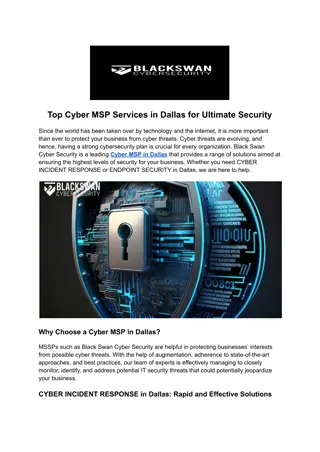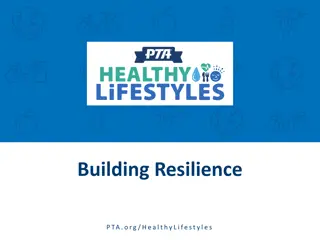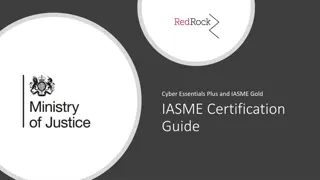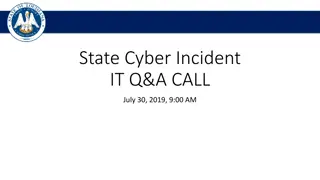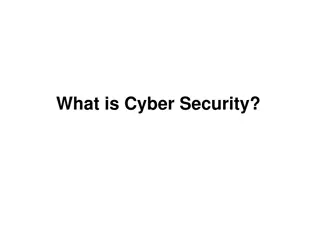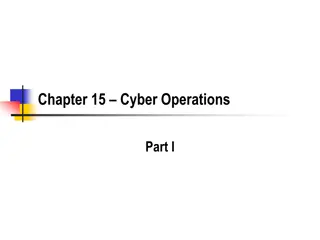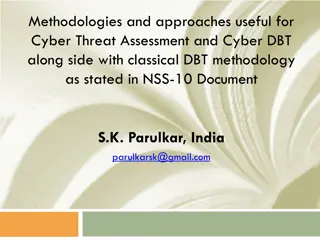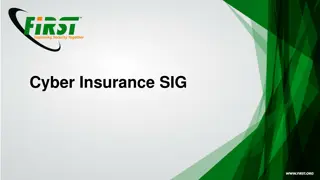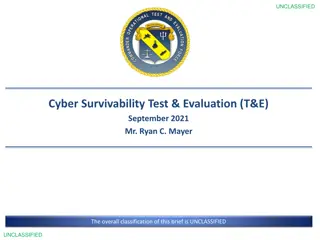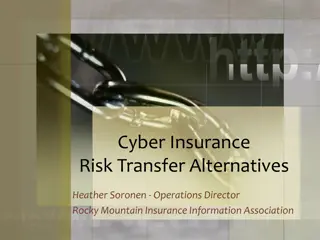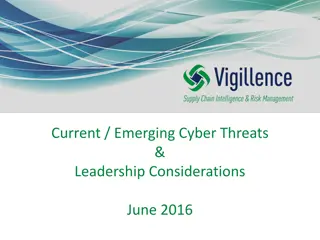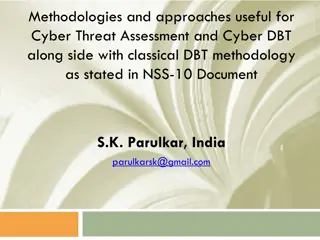Building Resilient Communities: Cyber Resilience View
This work explores resilience in the context of cybersecurity and cybercrime, focusing on aspects like risk, prevention, adaptive offenders, and the human side of security. It covers various definitions of resilience relevant to security domains such as ecology, engineering, organizational, economic/business, network, control system, and security DHS. The discussion emphasizes the importance of adaptation and risk management in building resilient communities against cyber threats.
Download Presentation

Please find below an Image/Link to download the presentation.
The content on the website is provided AS IS for your information and personal use only. It may not be sold, licensed, or shared on other websites without obtaining consent from the author.If you encounter any issues during the download, it is possible that the publisher has removed the file from their server.
You are allowed to download the files provided on this website for personal or commercial use, subject to the condition that they are used lawfully. All files are the property of their respective owners.
The content on the website is provided AS IS for your information and personal use only. It may not be sold, licensed, or shared on other websites without obtaining consent from the author.
E N D
Presentation Transcript
UCLDEPARTMENTOFSECURITY & CRIMESCIENCE Resilience to (Cyber)Crime a View from Design and Crime Science Paul Ekblom EPSRC cSALSA project / National CyberSecurity Centre workshop on Citizen-Centred Cyber Resilience: Building Resilient Communities from the Ground up 4 March 2020 This work was supported by the research project, ACCEPT: Addressing Cybersecurity and Cybercrime via a co-Evolutionary aPproach to reducing human-relaTed risks" (http://accept.cyber.kent.ac.uk/), funded by the EPSRC (Engineering and Physical Sciences Research Council) in the UK, under grant number EP/P011896/1 and EP/P011896/2.
Coming up Defining resilience diversity of concept Risk, prevention and resilience how they relate Different aspects of resilience to focus on The challenges facing cyber resilience efforts Adaptive offenders Arms races and co-evolution The human side of resilient security (and resilient crime) The roles people and organisations play in crime and civil life Professional know-how in security Involving 3rd parties in security mobilisation and behaviour change
Resilience Many definitions, all with relevance to security Ecology, Engineering The capacity of a system to absorb disturbance and reorganise while undergoing change so as to retain and/or quickly recover essentially the same function, structure, identity, and feedbacks Organisational The ability of an organisation to adapt and survive in the face of threats, including the prevention or mitigation of unsafe, hazardous or compromising conditions that threaten its very existence Economic/business The ability of a local economy to retain function, employment and prosperity in the face of the perturbation caused by the shock of the loss of a particular type of local industry or employer Network The ability of the network to provide and maintain an acceptable level of service in the face of various faults and challenges to normal operation Control system Ability to maintain state awareness and an accepted level of operational normalcy in response to disturbances, including threats of an unexpected and malicious nature Addressing complex control system interdependencies, including human-systems interaction Security DHS Ability to resist, absorb, recover from or successfully adapt to adversity or a change in conditions Note salience of adaptationthroughout . But place to start is risk
Risk, Prevention and Resilience roughly distinguished Prevention (to protect) Possibility what criminal events or conditions do we want to avoid? Preparation (to mitigate) Detect anomaly Respond Forensics for later adaptation Before event/ condition (anticipation, fear) Likelihood of events/conditions During Risk Uncertain future criminal events or prolonged conditions After Harmful consequences of events/conditions Immediate Knock-on Resilience Avoid/anticipate harm Resist/absorb harm Restore to function Reorganise and adapt to changes To victims To specific 3rd parties To society
Resilience of We can focus on different aspects of resilience in security Main cyber system/network the asset we are protecting/ preserving Intrinsically resilient (architecture redundancy, modularity etc) Resilience conferred by security features/add-ons (back-ups, firewalls etc) Protective security resilience of security features/elements themselves, and entire security system, against attack/countermeasures Note also that Offenders and OCGs/networks can be resilient or fragile Their planning, plans, preparations, actions, recruitment, trust can be disrupted by Law Enforcement, Administrative Action or indeed rivals in crime
The Challenges that Cyber Resilience must face Which challenges to resilience are most relevant to (cyber)security? Threat differs from accidental/natural hazards Malintent purposive, goal-directed Accessibility and nature of attack surface and wider environment of opportunity Capability/resources/affordances for crime Scale of challenges many crimes/opportunities/offenders, diversity of contexts for crime Speed of change (e.g. exponential growth of IoT) makes it harder for law, law enforcement, security to adapt in turn Complexity of interactions between components of systems, services, users makes it harder to predict, cope with diversity of combinations Lack of constraints cyber world defined by codes/conventions, not physical limits e.g. inertia, space, time
Offender Actions/ Affordances Misdeeds & Security Framework Neither Protect nor Prepare get to grips with the adaptation dimension of crime and security Mistreatment (damage/ harm) ICT as Target of crime Misappropriation (theft) Mishandling (e.g. fraud) Adaptive, innovative offenders What adaptive offenders get up to ICT as Contributor to crime eg resource Misuse (as tool/weapon) Misbehaviour (nuisance, conflict)
Arms races cultural co-evolution of crime and security Adaptability covers both sides We can see cultural co-evolution in arms races between offenders & security Safes and safebreakers Coders and codebreakers Arms and armour Detection/concealment of weapons, explosives Well-documented example Rick Brown on car theft The changing social and technological background can favour first one side, then the other e.g. radically better cutting tools, resistant materials emerge at various times Hence strategic importance for security side of developing, disseminating, maintaining Capacity to out-anticipate and Capacity to out-innovate adaptive offenders
Co-evolution How to Run Arms Races by Boosting Good Side, Blocking Bad Encourage variety of security solutions (if not, crack one, crack all) Creativity, innovation, evidence-based and theoretically/practically sound proposals, tested iteratively Design to performance standards/ generic principles, not fixed construction standards Avoid rigidity crime changes but your security can t Study offender resources current and future technologies, services Block their access to the resources Lock them into particular approaches Limit their R&D, security by obscurity Future proofing Anticipation Upgradeability Pipelines of innovations Ready to deploy new security at speed/scale
Learning from other Co-evolutionary Struggles Military Predator-prey Pest-farmer Bacteria-antibiotic Immune system-virus https://www.researchgate.net/publication/238196942_Can_We_Make_Crime_Prevention_Adaptive_by_Learning_from_Other_Evolutionary_Struggles
The Human in Resilience The human component of an ICT system has an ability to quickly understand novel solutions, and to adapt to unexpected conditions Humans can therefore provide additional resilience to, for example, a control system but Reliably predicting and influencing human behaviour is a continuing challenge Consider current issue of Corona virus hygiene Human individuals, groups and communities play a diversity of roles in relation to crime and security important to map these out
Crime Roles Who is involved with crime, How? The causes of criminal events can be mapped by the Conjunction of Criminal Opportunity This identifies several roles relating to crime whether material or cyber
Defining and characterising the crime roles Roles can be played by individuals, networks, groups or institutions Preventers can be Official, formal and professional, e.g. police, IT security managers Informal, e.g. a user vigilant against phishing or a passer- by intervening to thwart a robbery Crime roles can overlap, e.g. the same person or organisation can be both victim, and preventer or promoter
Crime X Civil/ legitimate roles Crime roles can overlap with civil (legitimate) roles E.g. in the normally legitimate activity of commercial waste disposal, an Employee of the waste carrier company could be an Offender, a Promoter, a Victim We can use this understanding of crime and civil roles to consider Who, currently or in future, may play what part in generating, preventing, responding to or mitigating crime Which are the civil roles in ICT that can direct, support or thwart mitigation and resilience? How do the players undertake their actions?
Professional Know-How Crime Prevention Process Professionals undertaking the roles of Preventer and Mitigator usually follow a structured process, typically SARA The 5Is process model is a more detailed counterpart to SARA In particular, 5Is differentiates the Response stage of SARA into 3 distinct task streams: Intervention reducing risk Implementation practicalities Involvement the people and organisations side of implementing the intervention, going beyond the security professionals In turn, these tasks are differentiated further still
Involvement of 3rd parties Non-security professionals Involvement can take various forms, including Partnership Mobilisation of one set of actors by another Climate setting (e.g. ensuring that employees accept and actively support IT security practices within a company)
Involvement Mobilisation Mobilisation is about getting people or organisations to Undertake crime prevention tasks, responsibilities or roles, or to desist from acting as crime promoters Mobilisation can be Direct (e.g. motivate people to implement intervention) Indirect or multiple e.g. chains of implementation, where one set of people/organisations mobilises another... The mobilisation process can itself be characterised by CLAIMED and perhaps co-design
Involvement Chain: Who to influence in promoting a secure future? Many civil roles may have to be influenced in concert to act as preventers or mitigators and foster crime reductive outcomes Consider this example from the commissioning, design, marketing, retail, use and disposal of some future product (material or cyber) which has the potential to be Misappropriated as a target of theft or Misused as a tool for crime
Alternative approach to mobilisation Behaviour Change Wheel http://www.behaviourchangewheel.com https://theoryandtechniquetool.humanbehaviourchange.org/tool
Thank you! p.ekblom@ucl.ac.uk http://5isframework.wordpress.com www.designagainstcrime.com/methodology- resources/crime-frameworks
